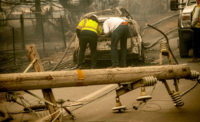As wildfire warnings continue to race through California, utility giants PG&E and Southern California Edison (SCE) are stepping up their fire-risk mitigation plans for workers to harden infrastructure and manage vegetation. At the same time, the state’s utility providers are facing continued public backlash about preemptive power outages, known as Public Safety Power Shutoffs (PSPS) as a fire-prevention strategy.
The International Brotherhood of Electrical Workers (IBEW) Local 1245, which represents more than 12,000 frontline PG&E and utility workers, says 3,000 linesmen are currently working on tree trimming and vegetation clearance, up from an average of 1,200 workers, says Tom Dalzell, business manager for IBEW. He expects the pace and rate of work to continue as the new normal for years.
“This is an hour or a time in history where utilities need engineers and field workers more than ever before and the type of financial leadership we have seen is now less important,” Dalzell says. “ ‘Let’s bring back the engineers’ is my mantra—financial people cannot figure out how to best sectionalize and segment lines or to harden systems.”
Between Oct. 9 and Oct. 13, PG&E implemented its seventh and largest shutdown after the National Weather Service issued red-flag fire warnings due to dry conditions, hot weather and winds throughout the state. PG&E expects that PSPSs will be part of the utility’s fire-prevention strategy for the next 10 years, CEO Bill Johnson told the CPUC at an Oct. 18 emergency meeting.
But that timeline only fanned the flames of growing public and state outrage as PG&E warned more than 200,000 Northern California customers of a second possible shutdown in two weeks due to fire-watch warnings as offshore winds, low humidity and dry vegetation combined throughout the state.
“What I was intending to convey is that we have a 10-year period in front of us where we would limit [power outages] every year, make narrower in scope,” says Johnson, defending the time frame as “realistic” at an Oct. 21 press conference. “But at the same time as we are reducing our element of risk, the fire risk is increasing—this is not a static condition; it’s dynamic, and the risk gets higher every year and I just think it takes a period of time given the experience of weather in this state to get to that point.”
PG&E is not the only California utility struggling with fire-risk mitigation. The National Weather Service predicts above normal “significant wildfire potential” from California’s northern to its southern border for October and large similar swaths of the state through December.
Southern California Edison’s annual mitigation plans for year-round fire risk allot for the hiring of thousands of contractors to enact construction standards and vegetation management. “What we are talking about is the number of dead and dying trees in our state, and it’s just a tinder box that is created,” says David Song, SCE public information officer. “That is a variable you can’t undersell; it’s truly an issue that we are tackling on a statewide level.”
SCE said that while that work has accelerated in volume and size in the past two years, the utility’s business practices have not changed significantly and interested vendors can still apply for contract work through SCE’s five-step process.
At the same time, Dalzell notes that safety remains a concern for member workers, who have been accosted on site by angry customers, and for the public at large.
“We are all talking about the inconvenience from the PSPSs, and not the deaths from no PSPS,” says Dalzell.
What PG&E, SCE and IBEW agree on is that future fire-mitigation risk in California will include microgrids. IBEW’s Dalzell points to Paradise, Calif., which is using the form to rebuild after last November 2018’s Camp Fire, which killed at least 85 people and destroyed nearly 19,000 buildings.
PG&E was faulted for sparking that fire and forced with its parent company PG&E Corp. to file for Chapter 11 earlier this year. Together, they provide electricity to 16 million people in northern and central California.







